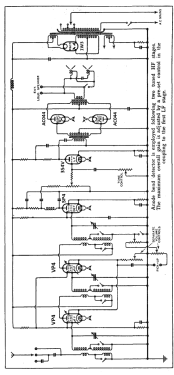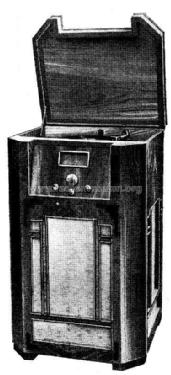Prism Radio-Gramophone
Prism Manufacturing Co.; Surrey
- Land
- Grossbritannien (UK)
- Hersteller / Marke
- Prism Manufacturing Co.; Surrey
- Jahr
- 1935
- Kategorie
- Rundfunkempfänger (Radio - oder Tuner nach WW2)
- Radiomuseum.org ID
- 336447
Klicken Sie auf den Schaltplanausschnitt, um diesen kostenlos als Dokument anzufordern.
- Anzahl Röhren
- 7
- Hauptprinzip
- Geradeaus ohne Rückkopplung; Anodengleichrichtung
- Wellenbereiche
- Langwelle, Mittelwelle (LW+MW).
- Spezialitäten
- Plattenspieler (kein -Wechsler)
- Betriebsart / Volt
- Wechselstromspeisung
- Lautsprecher
- 2 Lautsprecher
- Material
- Gerät mit Holzgehäuse
- von Radiomuseum.org
- Modell: Prism Radio-Gramophone - Prism Manufacturing Co.;
- Form
- Standgerät: allgemein.
- Bemerkung
-
FEATURES:-
Type: Radio-gramophone for AC mains with "straight" receiver circuit and special loudspeaker system.
Circuit: Two tuned HF stages with var-mu pentodes, pentode anode bend detector, triode 1st LF amplifier, push-pull triode output valves & full-wave valve rectifier.
Controls: Tuning, Volume & on-off switch, Tone & Wave range.
Chassis: Cast aluminum.
Price: 45 guineas.
- Originalpreis
- 47.25 GB £
- Literaturnachweis
- Wireless World (The), London (WW, 79) (Nov 22, 1935, Page 541)
- Autor
- Modellseite von Gary Cowans angelegt. Siehe bei "Änderungsvorschlag" für weitere Mitarbeit.
- Weitere Modelle
-
Hier finden Sie 2 Modelle, davon 2 mit Bildern und 1 mit Schaltbildern.
Alle gelisteten Radios usw. von Prism Manufacturing Co.; Surrey
Forumsbeiträge zum Modell: Prism Manufacturing: Prism Radio-Gramophone
Threads: 1 | Posts: 1
Prism Radio-Gramophone
Prism Radio-Gramophone Unique Acoustic System Provides Non-directional Radiation and Deep Bass
Both in conception and treatment, this instrument reveals refreshing originality of outlook on the part of the designers. The majority of radio-gramophones are built around the receiver chassis, which as often as not is identical to that used in one of the firm's current table models. In the Prism radio-gramophone, on the other hand, the nucleus of the equipment is the loudspeaker and its associated acoustic system. Starting from this point the makers have chosen a type of circuit which they regard as best suited to provide the necessary electrical input and finally a cabinet design, which, although imposing, is no more than is necessary to house the equipment provided. In evolving the acoustic system, the loudspeaker is used not so much for its direct radiation as for a driving force actuating an arrangement of tuned baffle boards which, to quote the maker's own words, ''refine, amplify and render non-directional the sound waves which they receive." Two permanent magnet moving coil units are used, and these are mounted with their backs to the front of the instrument. The first result of this is that focusing of high notes in a beam from the forward angle of the cone is eliminated, at least as far as the radiation from the front of the cabinet is concerned. Inside the cabinet, the beam is scattered, first by an arrangement of vanes in the form of what is perhaps best described as '1 stationary fan, and then by reflection from the main baffle boards. These are made from specially selected wood and are of varying thickness so that the reinforcement which they give to the bass by virtue of their natural periods is not confined to any one particular frequency.
Sound Distribution
The exceptionally broad and deep bass response and the apparently ubiquitous presence of sound, give the reproduction from this instrument a quality which is a welcome change from the stereotyped reproduction to which we have become accustomed from conventional loudspeaker arrangements. The sense that the performers are in the room itself will go far to commend this instrument to the music lover, and the absence of a harsh high-frequency response and background noises, in general, should remove the well-known prejudices of this class of listener against what they choose to term ''canned music.''
The choice of the circuit has contributed in no small measure to the reduction of background noise. Instead of the more usual superheterodyne, a straight circuit with two stages of high-frequency amplification has been adopted. This gives ample range and selectivity for all those stations capable of providing a program worthy of reproduction by this instrument. There are, of course, no second-channel whistles or other self-generated heterodynes on either waveband, and the intrinsic background noise of a straight circuit is, if anything, lower than that of a superheterodyne. In the case of the Prism receiver, it is possible to adjust the overall amplification to suit local conditions so that background noise can, if necessary, be reduced still further.
The two high-frequency amplifiers are transformer coupled and are of the variable-mu pentode type. There is no AVC, but its place is taken by the manual radio volume control which consists of a variable resistance common to the cathode return circuit of both valves. The detector stage also contains an HF pentode, though this is not of the variable-mu type. This valve functions as an anode bend detector and the input from the gramophone pick-up is injected in series with the coils associated with the tuned grid circuit. The manual volume control for the pickup is situated on the motor board, and an additional pre-set volume control designed to prevent overloading, even on the loudest types of record, is fitted in the set itself.
The detector is coupled to a triode amplifier through a resistance-capacity arrangement. Here again, a pre-set control has been incorporated to adjust the magnification of radio response to suit individual requirements. The output valves are triodes arranged in push-pull, the input transformer being parallel fed. The output is sufficient to work with one or more external loudspeakers in addition to those provided in the set. These are connected in parallel across the secondary of the output transformer, the smaller high-frequency speaker being fed through a large capacity condenser.
Range and Selectivity
One consequence of the low background level is that the set at first is apt to give an erroneous impression as regards its sensitivity. Further investigation, however, shows that on a normal aerial all those European stations which are generally relied upon for continuous program working will be received with an ample reserve in hand. There are three alternative aerial tapping’s, and with a full-size aerial connected to the most selective of these, it was found possible in Central London, to tune clear of the Brookman's Park transmitters with a margin of approximately two channels on either side. All the worthwhile long-wave stations are easily separated.
 The set is provided with a tone control which consists of a resistance-capacity filter across the input of the first LF stage. The values here have been carefully chosen, and while the range is sufficient to make an appreciable difference to the high-note response, it does not reduce this part of the frequency range to the point where reproduction could be described as muffled.
The set is provided with a tone control which consists of a resistance-capacity filter across the input of the first LF stage. The values here have been carefully chosen, and while the range is sufficient to make an appreciable difference to the high-note response, it does not reduce this part of the frequency range to the point where reproduction could be described as muffled.
Some care was found to be necessary when manipulating the radio volume control as there was a tendency for the range of the control to be concentrated near the top end. Further, the anode bend detector can be overloaded on the local station if the manual volume control is turned up too far. However, errors of adjustment which might arise from this cause will not occur if the station is accurately tuned first with the volume control turned down. A happy balance has been achieved in the reproduction of gramophone records, and while there is ample top response it does not go high enough to bring in surface noise. The bass response is far better than one has been accustomed to expect from records, and instead of merely suggesting their presence the instrument reveals the double basses in their true function as the foundation of the orchestra. One interesting result of the acoustic design is that while the sound in a small room is never oppressive, it seems to possess great carrying power when used, say, in a small hall. The makers are to be congratulated on their courage in breaking away from conventional design and judging by the results, we would say that they have estimated to a nicety the predilections of the majority of listeners in the matter of tonal balance.
Wireless World Nov 22, 1935, Pages 541-542
Gary Cowans, 05.Mar.22

